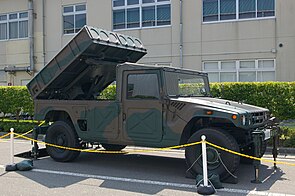Type 96 Multi-Purpose Missile System
| Type 96 | |
|---|---|
| General Information | |
| Type | Anti-tank guided missile |
| Manufacturer | Kawasaki Heavy Industries |
| development | 1986-1996 |
| Commissioning | 1986+ |
| Unit price | 18.4 million euros (including development costs) |
| Technical specifications | |
| length | 2 m |
| diameter | 160 mm |
| Combat weight | 59 kg |
| drive | Solid |
| speed | N / A |
| Range | > 10 km |
| Furnishing | |
| Target location | Imaging Infrared (IIR) |
| Warhead | Shaped charge |
| Detonator | A hit |
| Lists on the subject | |
The Type 96 Multi-Purpose Missile System ( Japanese 96 式 多 目的 誘導 弾 シ ス テ ム , 96-shiki tamokuteki yūdōdan shisutemu , dt. "Multipurpose guided missile system Type 96") is an anti- tank and landing craft defense weapon from Kawasaki Heavy Industries , which used by the Japanese Ground Self-Defense Forces . It is the first Japanese guided missile system that is fully digitally controlled.
Summary
The weapon was developed as a successor to the Type 79 Jyu-MAT . It is fired from an off-road vehicle that is armed with six missiles. After the launch, the rocket pulls a fiber optic cable behind it, via which the image from the high-resolution infrared viewfinder is transmitted to the shooter's display in the vehicle. The shooter can now assign a target to the missile or steer it manually into a target. The system is thus able to destroy targets out of sight (non-line-of-sight). Due to the attack from above and the generously dimensioned warhead , the guided missile is able to destroy any tank. The shaped charge warhead is oversized for tanks in order to be able to fight small ships (e.g. landing craft ). The weapon can also be used against helicopters in an emergency. Due to the long range of the system (the maximum range was not disclosed), practice shots can only take place at the Yakima Training Center in the USA.
